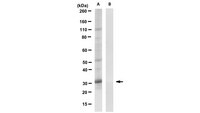MABF2006-100UG Sigma-AldrichAnti-CHIKV CP Antibody, clone 5.5G9
Anti-CHIKV CP, clone 5.5G9, Cat. No. MABF2006, is a mouse monoclonal antibody that detects CHIKV Capsid protein (CP) and has been tested for use in ELISA, Immunohistochemistry and Western Blotting.
More>> Anti-CHIKV CP, clone 5.5G9, Cat. No. MABF2006, is a mouse monoclonal antibody that detects CHIKV Capsid protein (CP) and has been tested for use in ELISA, Immunohistochemistry and Western Blotting. Less<<お勧めの製品
概要
| Replacement Information |
|---|
| References |
|---|
| Product Information | |
|---|---|
| Format | Purified |
| Presentation | Purified mouse monoclonal antibody IgG2a in PBS without azide. |
| Physicochemical Information |
|---|
| Dimensions |
|---|
| Materials Information |
|---|
| Toxicological Information |
|---|
| Safety Information according to GHS |
|---|
| Safety Information |
|---|
| Packaging Information | |
|---|---|
| Material Size | 100 μg |
| Transport Information |
|---|
| Supplemental Information |
|---|
| Specifications |
|---|
| Global Trade Item Number | |
|---|---|
| カタログ番号 | GTIN |
| MABF2006-100UG | 04054839646751 |
Documentation
Anti-CHIKV CP Antibody, clone 5.5G9 試験成績書(CoA)
| タイトル | ロット番号 |
|---|---|
| Anti-CHIKV CP, clone 5.5G9 - 3849508 | 3849508 |
| Anti-CHIKV CP, clone 5.5G9 - 4134985 | 4134985 |
| Anti-CHIKV CP, clone 5.5G9 - Q3173783 | Q3173783 |







